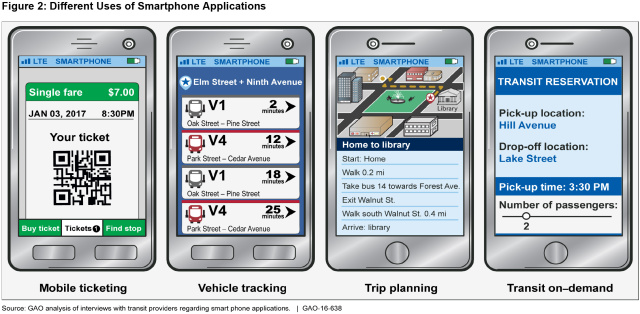Technology in Transit
 (Excerpted from GAO-16-638)
(Excerpted from GAO-16-638)
(Excerpted from GAO-16-638)
Many of the benefits of ITS come from technologies working in tandem. For example, data on vehicle location, passenger counts, and electronic fare payment can help transit agencies understand the behavior of their customers, and adjust their operations to make their journey more pleasant. In fact, even transit agencies in small towns and rural areas are using ITS to enhance their security, computer-aided dispatch, automatic vehicle location, and geographic information systems (GIS). …though implementation isn’t easy (or cheap!) However, even if a transit agency is eager to take advantage of ITS, it must still convince its leadership that this new technology is a good investment. For example, ITS systems have ongoing operations and maintenance costs that agencies have to fund while continuing to preserve or add new infrastructure (such as replacing buses). Transit agencies in rural areas may also face connectivity challenges since ITS must reliably transmit data, such as vehicle location, between various systems. The Department of Transportation offers technical assistance programs, training, and webinars on ITS, but many of the local transit agencies we looked at didn’t know about these resources. To find out more about how DOT can help local transit agencies use ITS, check out our full report.- Questions on the content of this post? Contact Mark Goldstein at goldsteinm@gao.gov.
- Comments on the WatchBlog? Contact blog@gao.gov.

GAO's mission is to provide Congress with fact-based, nonpartisan information that can help improve federal government performance and ensure accountability for the benefit of the American people. GAO launched its WatchBlog in January, 2014, as part of its continuing effort to reach its audiences—Congress and the American people—where they are currently looking for information.
The blog format allows GAO to provide a little more context about its work than it can offer on its other social media platforms. Posts will tie GAO work to current events and the news; show how GAO’s work is affecting agencies or legislation; highlight reports, testimonies, and issue areas where GAO does work; and provide information about GAO itself, among other things.
Please send any feedback on GAO's WatchBlog to blog@gao.gov.

